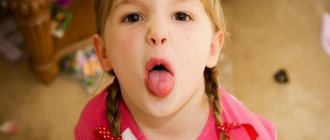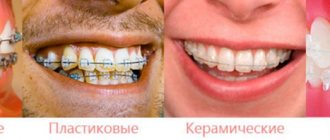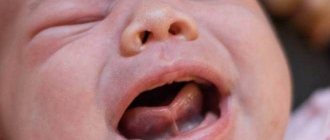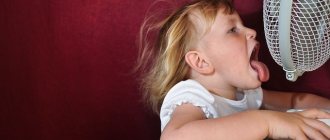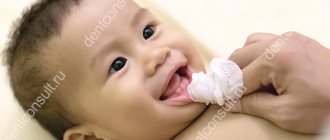Types, levels and forms of speech dysarthria in children
Table of types of disease by location of the lesion
| Name of the pathology form | Peculiarities |
| Cerebellar | Occurs when the cerebellum is involved in the process. Speech is drawn out, slurred, slow, the volume constantly changes, the child’s tongue trembles, he speaks with shouts, as if chanting slogans. Additional symptoms: poor balance, unsteady gait. |
| Bulbarnaya | It is caused by paralysis of the articulatory muscles, as well as the nerves - vagus, glossopharyngeal, ternary, sublingual and/or others. Children lack some reflexes, sucking and swallowing, facial expressions are impaired, and it is difficult for them to chew solid food. There is also increased salivation, simplification (all consonants “merge” into one fricative) and slurred sounds, a nasal, hoarse sound of the voice, sometimes its absence. |
| Pseudobulbar | Occurs with centralized paralysis (spastic) of muscles and their hypertonicity. Speech becomes monotonous, it is difficult for the child to lift the tip of the tongue, move it to the side, or hold it. There is increased salivation, soreness, and swallowing disorders (increased reflex). Speech is slurred, nasal, the pronunciation of hissing, whistling and tone sounds is sharply impaired. |
| Extrapyramidal | It occurs when the function of the subcortical nuclei is disrupted, and therefore received a second name – “subcortical”. Speech is slightly nasal, slurred, and slurred. There are involuntary muscle movements, facial expressions, and articulatory spasms. The timbre and strength of the voice changes, the pace of conversation is disrupted, and there are occasional guttural cries. |
| Cortical | Damage to those areas of the cerebral cortex that are responsible for articulatory muscles. Children pronounce words correctly in structure, but with impaired pronunciation of syllables. There is difficulty breathing during conversation and voice. |
| Cold | Manifests itself as one of the symptoms of myasthenia gravis (fatigue and weakness of striated muscles). Speech disruptions occur when the air temperature in the room where the child is located increases or decreases. |
Classification according to the degree of development of pathology:
- I (erased) - only a speech therapist can identify incorrect pronunciation during examination and examination, almost complete recovery is possible;
- II – pronunciation is clear, but defects are noticeable;
- III – the child is understood only by close people, strangers rarely;
- IV – even relatives do not understand the pronunciation or there is no speech, most often considered within the framework of cerebral palsy.
Important! The erased form is characterized by difficulty chewing solid food. Parents should not change their child's diet because of this. It is necessary to gradually accustom him to chew on the same basis as other people. Source: E.F. Arkhipova Erased dysarthria in children: a textbook for university students // M.: AST: Astrel: KHRANITEL, 2006, p.319
Speech therapy tongue massage
The tongue is the main organ of speech. Therefore, speech therapy massage of the tongue for dysarthria is a necessary element of treatment. Helps fight weakness, limited muscle mobility, paresis and paralysis. Specialists use several techniques in their work. Let's take a closer look at them.
Massage with a toothbrush
A toothbrush, due to its bristles, perfectly warms up the tongue. It can be used both in classes with a speech therapist and for independent speech therapy massage at home. The approximate steps are as follows:
- Place a paper napkin or handkerchief under your tongue to prevent saliva from running off and irritating your skin. When the napkin gets wet, you need to change it;
- the child should relax his tongue as much as he can;
- first perform circular kneading movements along the back of the tongue, the pressure should not be strong;
- stroking over the entire area of the tongue, intermittent movements, as when brushing teeth;
- the baby tenses his tongue, lifting it upward, you massage the lower part of the tongue and the pit under it.
When massaging, be careful not to trigger a gag reflex in the child.
Tongue massage with fingers
Finger speech therapy massage of the tongue for dysarthria allows you to work all muscle groups, including deep ones. Sessions help relieve hypertonicity of facial and articulatory muscles. To carry out the procedure, you need a clean handkerchief, fabric napkins, and special finger pads.
The stages are:
- Relaxation of the tongue muscles;
- Grab your tongue with two fingers, twist it clockwise and counterclockwise, tap on the back;
- Move towards yourself, while grabbing the tip with three fingers: one from above, two from below;
- Now let's deal with the middle part of the tongue. Also grab your tongue and pull it towards you, holding this position for a couple of seconds;
- Grab your tongue and pull it towards you a little. In this position, use the fingers of your other hand to make squeezing movements over the entire surface of the tongue. They squeezed - they let go, they squeezed - they let go;
- Turns around an axis, while the tongue needs to be placed on one edge, hold it for a couple of seconds, then on the other edge;
- It is also necessary to work with the lips - their role in articulation is significant. Tap them with your fingertips, stretch them up and down, and roll them into a tube.
Speech therapy massage for various forms of dysarthria should be performed once or twice a day, for 15 minutes, for a couple of weeks. The speech therapist will tell you the exact duration and quantity: it all depends on the diagnosis and the degree of impairment. Also consider age: small children cannot sit for long, so choose a few exercises one day and do only them. And the next day, do others.
Probe massage
One of the modern correction methods is probe massage for dysarthria. This is one of the new treatment methods that is gradually gaining popularity. It is carried out using special probes developed by E. V. Novikova, Doctor of Pedagogical Sciences.
The standard set consists of 9 tools, each of which is designed for specific purposes. For example, sleds, shaped like sled runners with rounded ends, are designed to stimulate muscles. The “hatchet” in the form of two flattened loops can be used with both increased (light pressure) and decreased tone (strong pressure) of the muscles.
There are variations by other authors, for example, probes with a su-jok effect for additional stimulation of nerve endings and muscles.
After the sessions, children’s speech breathing normalizes, their voice becomes expressive and strong, defects in sound pronunciation are eliminated, and the condition of the central nervous system improves.
Articulatory massage with probes for dysarthria should not be performed on children under six months; at this age there is no such need.
The sequence of a relaxing massage is determined by a speech therapist/speech pathologist, based on the specific situation, the severity of the disease and the age of the patient. The standard tactics are as follows:
- The tool in the form of a small ball needs to be moved over the entire surface of the tongue;
- Piercing the tongue with a pitchfork-shaped probe. Muscle contraction occurs. Then the doctor makes oscillatory and rotational movements with the instrument at various points for five seconds;
- Using a figure eight, press on the organ at several points;
- “Sleds” come in three sizes. They also make pressing movements;
- "Hatchets" are used to slide with little pressure;
- Use a “crosspiece” or “pusher” to press on the tongue, and then remove the probe. The muscles of the tongue contract.
Probe massage for dysarthria is carried out for a long time: usually in courses of 2–3 weeks. Each movement must be repeated 20–30 times. A repeat course is indicated after a month and a half.
Causes and symptoms
The disease is provoked by a number of harmful factors:
- viral diseases of the expectant mother;
- pathologies of the placenta at the stage of intrauterine development;
- Rhesus conflict;
- fetal hypoxia;
- very rapid or slow labor with cerebral hemorrhage in the child;
- some birth injuries;
- prematurity;
- infections of the brain and its membranes, such as meningitis;
- Cerebral palsy (up to 85% of cases of dysarthria);
- TBI;
- hydrocephalus;
- severe intoxication;
- encephalitis. Source: L.I. Belyakova, Yu.O. Filatova Diagnosis of speech disorders // Defectology, 2007
Why is muscle hypotonicity dangerous?
Muscular hypotonia is fraught with inhibition of the baby’s physical development. Children with uncorrected problems are very different from their peers. They are weakened, lethargic, passive, and they develop crawling and walking skills later than their peers.
Signs of muscle hypotonicity, undiagnosed in early childhood, manifest themselves at school age in the form of impaired posture, stooping, and poor handwriting. Children who had decreased muscle tone in infancy have difficulty performing physical exercises.
In the absence of treatment or its ineffectiveness, muscle hypotonia is dangerous due to the development of complications in the form of:
- delays in psychomotor development;
- curvature of the spine;
- posture disorders;
- muscle weakness and dystrophy.
Symptoms and treatment
The main symptoms include the following:
- incomprehensible, slurred speech;
- spastic manifestations in the articulatory muscles (neck, lips, face, tongue are constantly tense, articulation is limited, lips are tightly closed);
- hypotonia of the articulatory apparatus (lips do not close, tongue lies motionless in the mouth, mouth is slightly open, increased salivation);
- dystonia of articulatory muscles (when a child tries to talk, his muscle tone goes from low to high);
- slurred pronunciation;
- in difficult cases, the child misses sounds, replaces them or pronounces them distorted; Source: O.Yu. Fedosova Features of sound pronunciation of children with mild dysarthria // Speech therapist in kindergarten, 2005, No. 2, pp. 36-41
- slowness of conversation;
- inability to speak (in severe forms);
- nasal voice without signs of a runny nose;
- change, omission, replacement of some sounds with others;
- fading of a phrase towards the end of its utterance, rapid breathing during a conversation due to lack of air;
- very high, almost “squeaky” voice;
- a fast or very slow flow of words, while the child cannot change the tone.
Gymnastics for making the sound R
One of the ways to develop tongue mobility, give it strength, flexibility, and improve switchability, is articulatory gymnastics. It is worth noting that improving tongue mobility has a beneficial effect not only on sound pronunciation, but also on the orthodontic situation, and is also a preventive measure to prevent the frequent occurrence of caries, because “stagnation” in the mouth contributes to the development of microbial flora that causes caries.
In the video below, speech therapist T.B. Zukor shows in detail all the exercises necessary to produce the sound P at a slow pace and gives comments on the duration of their implementation.
- Exercises “Walruses” and “Spatula” are necessary for relaxing the tongue.
- Exercises “Delicious Jam”, “Drum”, “Horse” and “Sail” train the muscles of the tongue, preparing them for the correct pronunciation of the sound R.
- Exercises “Brushing your teeth” and “Football” are performed to improve the flexibility and mobility of the tongue.
- The “Focus” exercise is performed to develop a strong directional air stream necessary for the sound R.
- The “Motor” exercise is the final step towards producing the sound R.
To automate the sound P, it is necessary to perform tasks and exercises for a sufficiently long time. Especially if the child needs frenuloplasty or treatment of ENT organs and restoration of nasal breathing.
If after watching the video you still have questions, sign up for a consultation with a speech therapist by phone or through the form on the website. You can ask questions about speech therapy to T.B. Zukor on her page in.
What to do? Treatment methods for the disorder
The child must undergo additional classes with a speech therapist (at home or in a special institution) on:
- development of motor skills;
- forming a conversation;
- honing diction;
- correcting the pronunciation of distorted sounds;
- expanding vocabulary;
- development of phonetic hearing;
- memorizing grammatical structure.
Against this background, drug therapy is carried out using nootropics. Medicines in this group specifically affect brain functions: stimulate mental activity, cognitive functions, increase learning abilities, and improve memory.
The package of measures also includes exercise therapy - articulation gymnastics to strengthen the facial muscles, massage, exercises with the hands and fingers.
Sources:
- E.F. Arkhipova. Erased dysarthria in children: a textbook for university students // M.: AST: Astrel: KHRANITEL, 2006, p. 319.
- L.I. Belyakova, Yu.O. Filatova. Diagnosis of speech disorders // Defectology, 2007.
- 3. O.Yu. Fedosova. Features of sound pronunciation of children with mild dysarthria // Speech therapist in kindergarten, 2005, No. 2, pp. 36-41.
The information in this article is provided for reference purposes and does not replace advice from a qualified professional. Don't self-medicate! At the first signs of illness, you should consult a doctor.
How to determine decreased muscle tone?
In some cases, manifestations of muscle hypotonicity are not clearly expressed and are not immediately detected by parents and pediatricians. Symptoms may also vary depending on the age of the child and the severity of the underlying disease. During the initial examination of the baby, a decrease in muscle tone is identified as a separate syndrome. To establish the cause of its development, the neurologist prescribes a comprehensive examination of the child and, if necessary, involves specialists of various profiles (endocrinologist, rheumatologist, geneticist, immunologist) as consultants.
